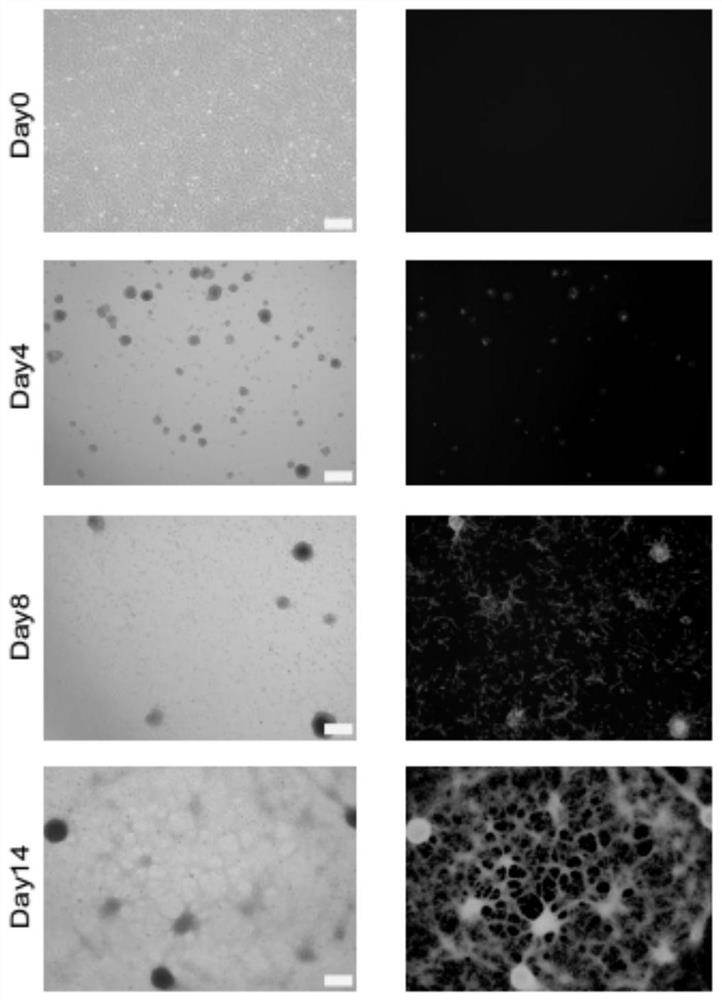Method for Inducing Growth Factors to Generate Neural Precursor Cells
A technology of neural precursor cells and growth factors, applied in nervous system cells, biochemical equipment and methods, animal cells, etc., can solve problems such as tumorigenicity, gene insertion mutation, unfavorable cell transdifferentiation technology application, etc., to achieve Reduce tumorigenicity, improve the effect of low-efficiency, high-efficiency cell transdifferentiation methods
- Summary
- Abstract
- Description
- Claims
- Application Information
AI Technical Summary
Problems solved by technology
Method used
Image
Examples
Embodiment 1
[0043] Common mouse embryonic fibroblasts were prepared and cultured in embryonic fibroblast medium. Thereafter, cells were seeded in 24-well cell culture plates at a density of 150,000 cells / well, using induction starter medium. During the first 7 days of induction, the cells were gently blown once a day in order to suspend the aggregated cells and form a better cell sphere. After 7 days, the cells were no longer blown and blown, so that the cells rapidly expanded from the adhering clumps, and regional proliferation of the cells could be observed. 14 days after the initiation of induction, the cells in each well of the 24-well culture plate were digested with trypsin / EDTA (Invitrogen), spread into a corresponding 35mm cell culture dish, and the culture system was replaced with fresh neural stem cells at this time Medium. After continuing to culture for 7 days, it can be observed that the adherent cells will proliferate regionally, and many neuroepithelial-like cells crawl o...
Embodiment 2
[0045] Nestin-GFP mouse embryonic fibroblasts were prepared and cultured in embryonic fibroblast medium.
[0046] (1) Cells were planted in a 24-well cell culture plate at a density of 150,000 cells / well, and the culture system was replaced with fresh induction starting medium. During the first 7 days of induction, the cells were gently blown once a day in order to suspend the aggregated cells and form a better cell sphere. After 7 days, the cells were no longer blown and blown, so that the cells rapidly expanded from the adhering clumps, and regional proliferation of the cells could be observed. 14 days after the initiation of induction, the cells in each well of the 24-well culture plate were digested with trypsin / EDTA (Invitrogen), spread into a corresponding 35mm cell culture dish, and the culture system was replaced with fresh neural stem cells at this time Medium. After continuing to culture for 7 days, it can be observed that the adherent cells will proliferate region...
Embodiment 3
[0049] Molecular and functional identification of the neural precursor cells obtained by the growth factor induction method obtained in Examples 1 and 2:
[0050] (1) extract the RNA of the neural progenitor cell that embodiment 1 and 2 obtain, and carry out real-time quantitative PCR detection, find that cell 1# and 2# have highly expressed neural progenitor cell molecular markers such as Nestin, Pax6 and Sox2, but not The original fibroblast markers Thy1 and Col3a1 were expressed again, which proved that the neural precursor cells obtained in Examples 1 and 2 did have the characteristics of neural precursor cells. Figure 5 shown.
[0051] (2) Extract the RNA of the neural precursor cells obtained in Examples 1 and 2, and perform gene expression profiling analysis on cells 1# and 2# through the next-generation sequencing technology-RNA-seq, which proves that these cells are derived from global gene expression The angle is very similar to the obtained neural progenitor cells...
PUM
 Login to View More
Login to View More Abstract
Description
Claims
Application Information
 Login to View More
Login to View More - R&D
- Intellectual Property
- Life Sciences
- Materials
- Tech Scout
- Unparalleled Data Quality
- Higher Quality Content
- 60% Fewer Hallucinations
Browse by: Latest US Patents, China's latest patents, Technical Efficacy Thesaurus, Application Domain, Technology Topic, Popular Technical Reports.
© 2025 PatSnap. All rights reserved.Legal|Privacy policy|Modern Slavery Act Transparency Statement|Sitemap|About US| Contact US: help@patsnap.com



